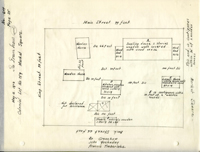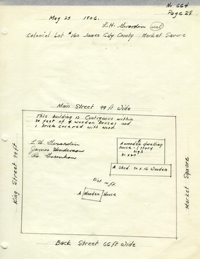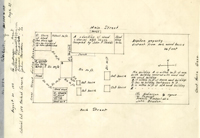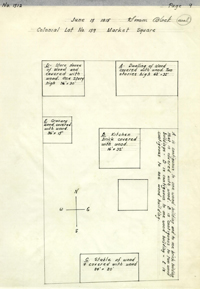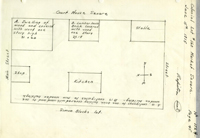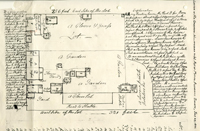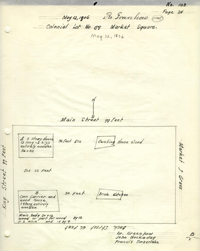John Greenhow House Historical Report, Block 13-2 Building 23E Lot 159-160 Originally entitled: "Colonial Lots 159 and 160 Block 13-2 Present Location of the Travis House"
Colonial Williamsburg Foundation Library Research Report Series - 1264
Colonial Williamsburg Foundation
Library
Williamsburg, Virginia
1990
COLONIAL LOTS 159 and 160
BLOCK 13-2
PRESENT LOCATION OF THE TRAVIS HOUSE
The Frenchman's Map of c.1782 is the first indubitable proof that there were houses -- both large and small -- on what appears to be the present Block 13-2. The location of the houses on these lots is shown below:
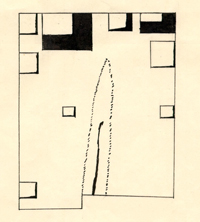
The Bucktrout Map of 1803 (belonging to Miss Estelle Smith) has the name "Greenhow" in Lots 159 and 160. Although the Unknown Draftsman's Map of uncertain date has no lot numbers in similarly placed lots, it does show the name "Greenhow" in both lots.
A letter written1 by Robert Greenhow* at Williamsburg, July 27, 1801 contains pertinent information about his property in that town. He writes … "after critically viewing the property 2 (a plan of which on a scale of forty feet to the Inch, accurately drawn is annexed) 'have declared that it would cost in Cash 9200 Dollars in ready money to build the same; and is now, (after the deductions of 2200 Dollars for Decay or bad repair) actually worth 7000 Dollars in ready money'…The situation of my buildings are such as to place them in little or no Danger of fire from my Neighbours; The main Street is nearly 100 feet wide; to the west, 70 or 80 feet separates me from the next building; To the East I am perfectly secure, 12 or 1500 feet intervening of vacant Ground. To the South no buildings exist." (Photostatic copy, Department of Research and Record)
Greenhow estimated the value of his buildings as follows:
| Dwelling house | A | $5000 | actually now worth | 4000 Dolls |
| Brick kitchen | B | 1000 | Do | 900 |
| Lumber House | C | 400 | Do | 300 |
| Stable | D | 200 | New Do | 200 |
| Brick Dairy | G | 100 | Do | 100 |
| Do Storehouse | E | 1000 | Do | 940 |
| Dwelling house | F | 1500 | Do | 560 |
| $9200 | $7000 |
In the drawing Greenhow designated the part "Q" as used for domestic purposes. Part "A" may have been used as a store. He had offered goods for sale at his store in Williamsburg on Aug. 30, 1793; June 13, 1794; and Jan. 13, 1794. (Virginia Gazette and Richmond Chronicle, John Dixon) The newspapers of later dates have not been searched for advertisements of Greenhow's, therefore it is not possible to say how long he carried on the business of a merchant in Williamsburg.1
In 1806, in policy no. 103 p. 24, Greenhow insured his wooden storehouse for $1500 and his combined corn, carriage and wood house for $200. He described these buildings as occupied by himself -- that is, used by himself and "situated between the Lott of Peter Robert Deneufville and hisGreenhow's buildings declared by Declaration of Revaluation in policy no. 493." Peter Robert Deneufville was located at lot #355. (See chronological list in report on the Custis Tenement.) It will be noted that the store house was not on the plan of his building drawn in 1801. The Williamsburg Tax records (Va. State Archives) for 1807 have a record of a new store built by Robert Greenhow but does not locate this store. It is possible that Greenhow had replaced the combined lumber-house, granary, and wood house (C) shown in the drawing of 1801 by the new store and new corn, carriage and wood house.
On the same day, Greenhow insured his dwelling house with its out houses. He insured his "four Buildings on the Main Street now occupied by "self situated between the Lott of Peter Robert Deneufville and *(sic) L. H. Girardins DWg house in the county of James City". It will be seen from this description that Greenhow continued to rent or had sold the dwelling on the east. Greenhow valued his property as follows:
| Dwelling House | A | $5000. |
| Kitchen | B | 900. |
| The Stable | D | 160. |
| The Lumber House | E | 1000. |
| $7060. |
In the same month and year, Lewis R. Girardin insured "my one Building on the south side of the Main Street situated between Market Square East and the Lott of Robert Greenhow West." Girardin valued his dwelling house at $1500. This statement, as well as the fact that Girardin had the policy in his name (#664 p. 28) and was taxed for half a lot (see Photostat copies of the Williamsburg tax records for 1806) seems to indicate a sale.
By 1811, Robert Greenhow had sold or leased his western lot to John Page Shields, while Joseph Repiton was in possession 4 of the eastern dwelling and lot. In Revaluation no. 1082 of "Buildings declared for Assurance by Robert Greenhow as per Declarations Nos. 644 & 103." the appraisers declared that the said buildings were "owned by John Page Shields residing at Williamsburg in the County of James City and are occupied by himself and Edward Cheminant. That they [are] situated on the main and two other streets between the lots of Deneufville on the West and Repiton on the east in the County of James City".
Shields gave the following valuation of his property:
| The Kitchen | B | at | $ 333.1/3 |
| Stable | C | 225. | |
| The Store house | D | 1080. | |
| The Granary & C | E | at | 141.2/3 |
| The Dwelling | A | at | 2666.2/3 |
| $4446.2/3 |
Earlier, that is on April 5th, 1810, Greenhow had insured the lumber house which was south of his tenant's house. Greenhow described the building as being on the Court House Square situated between the lot of John P. Shields on the west, the Market Square on the east, and on the north and south by parts of the same lot on which it stood in the county of James City. He valued the Lumber House E at $1000.
Apparently the drawing usually appended was folded out of view before the photostat was made as only writing is found on the policy. The first statement (1) is made by the special agent, Anderson; the second (2) by the former owner of the property, Greenhow.
* J.P. Shields' lot and houses
- (1) Which buildings have lately been conveyed to John P. Shields. The object of the present revaluation appears to be to enable the ensured to receive from the general office a separate policy for this building, and not with any view to withdraw his previous ensurance, or forfeit the benefit derived by him, heretofore, in the payment of his premium on it.
Ro: Anderson." - (2) "Having sold to Mr Joseph Repiton, the lot, & the Improvements on which this brick house is erected for value by me Received All the Advantages Accruing in case of Conflagration are consequently attached to him. Wm.sburg April 19h. 1810 Ro. Greenhow"
A letter written in 1811, confirms the fact that the house in Williamsburg belonging to John P. Shields contained a garret. It reads as follows:
"August 7, 1811
Letter to Samuel Greenhow,"On Sunday evening last our city was alarmed by a fire which took place in the dwelling house of Mr. John P. Shields (late Mr. R. Greenhow's) which upon inspection appeared to be communicated to the building by some designing person probably with a view to plunder. In the absence of the proprietor and his family, a straw bed was taken from one of the lower rooms of the house, and placed in the garret with a chunk of fired wood under it, which soon communicated its head, and filled the room with flame. The garret being floored, and otherwise close, the fire did not readily extend itself, and being early in the evening, a discovery was made in time to preserve a total loss of the house and perhaps many of the neighbouring buildings…"
(Unknown writer to Samuel Greenhow, in Robert Anderson's Account Book, No. 2, p. 58, Virginia Historical Society.)
-o-
(A letter discovered after the completion of this report refers to a Greenhow home which had a new dining room. The location of this house is not known. The Unknown Draftsman's map shows the name "Greenhow" in five different localities in Williamsburg. The List of Land Taxes in 1806 shows that Robt Greenhow had seven lots in Williamsburg. Photostat copy of tax records in Virginia State Archives.)
Green Hill. March 9th 1808.
…
(Typed copy in Department of Research)
We have had a most superb, and brilliant Entertainment in the old city, it was called a Wickham Party or a Squeeze. I am sure if you were to guess a month, you could not tell where, I will no longer keep you in suspence, it was at Cousin Greenhows, in the new dining room, and quite in the Richmond style. All the world was there it appears to me. It was a general invitation, every body was invited, & Mr Greenhow said he felt quite happy, at seeing nearly the whole town of Wmsburg at his house, it was indeed a most splendid Ball, but too much crowded to be very agreeable ---"
E. Prentis to Mr. Joseph Prentis, Suffolk.
Robert Greenhow was recorder of the city of Richmond in June, 1812. (Calendar of State Papers X, 153)
5In 1815, Simon Block was in possession of the western part of Greenhow's lots, and Joseph Repiton was in occupation of the smaller dwelling on the east. Both insured their property:
Simon Block described his buildings on the Main Street now occupied by himself as "situated between Joseph Repiton's lot on the east and streets otherwise in James City County." The valuation was as follows:
(Policy no 1512 Revaluation of John P. Shields' declaration: 1082. June 15, 1815 p. 9)
The Dwelling House A at $4,500. The Kitchen B at 700. The Stable C at 150. The Storehouse D at 1,000. The Granary E at 100. $6,450.
At the same time (1815) Joseph Repiton insured his buildings (occupied by himself) on the Main Street and Court House Square as situated between Simon Block's lot* and streets otherwise in James City. The estimated value of his houses was:
6(Policy 1524, p. 45)
Dwelling House A at $1500. Lumber House B at 500. $2000.
A study of these insurance policies indicates that as early as 1801, Robert Greenhow owned two dwelling houses, each with outhouses, on the main street. The larger dwelling on the western part of the lot he occupied himself, the smaller one on the east was in the occupation of a tenant (Photostat letter, July 27, 1801). In 1806, he still occupied the house on the west, while L. H. Girardin occupied the smaller dwelling (Policies nos. 103, 644, and 664). In 1811, John Page Shields owned and occupied the dwelling house while Edward Cheminant occupied the store whether as renter or storekeeper for Shields or someone else is not clear. (Policy 1082, p. 27.) Joseph Repiton was in occupation of the smaller dwelling house in 1811. (Policy nos. 1022, 1082) In 1815, Simon Block occupied the large dwelling house, and Joseph Repiton continued to live in the smaller. (Policies nos. 1512 & 1524)
In the tax records for 1817, Peter Devergers was listed as having 3 lots. "2 via Simon Block Dwelling house containing one acre more or less, bounded on the North by the main street, on the east by Joseph Repiton, on the south by a back street." (Photostat copy of the Williamsburg tax records). This description of the location seems to fit the property under discussion in this report.*
The history of the former Robert Greenhow property after 1817 is a very complicated one, involving records in which there are many gaps. For that reason, the history that follows is suggestive rather than definitive.
In a dead from Wade and Maria Ann Mountforth to John M. Maupin on property on colonial lot #355 (not referred to by number in the deed), Mountforth describes the boundaries and location of his properties as follows:
"his houses and Lot in the City of Williamsburg nearly opposite the church and bounded on the north by the main street, on the east by a continuation of the Palace Street now closed and leased by the corporation of said City of Williamsburg to William Edloe, on the south by a back street …"(Mss. deed July 17, 1838 in Dept. of Research and Record.)
Edloe's property was the next east of lot #355 in 1838. Here Edloe had a stable, as will appear in a deed of that date. From 1835 through 1850, William Edloe (after 1847, his estate) was taxed for two lots, one with buildings valued at rates ranging from $1000 to $1500, the other with a building or buildings valued at $200. (Williamsburg Land Tax Records. Virginia State 7 Archives. Photostat, Dept. of Research and Record.)
Part of Greenhow's property came to be known as the City Hotel property even in a deed of the late nineteenth century. By inserting deeds and newspaper announcements in the tax records in chronological order, it is possible to trace the history, in part, of this hotel property.
| Year | Name | Residence | No. of Lots | Annual rent or Value | Value of lots & Buildings | Value due to Bldg. | Tax |
|---|---|---|---|---|---|---|---|
| 1818 | Peter Deverger | Wmsburg | 3 | 210 | 6.00 | ||
| 1819 | do | do | do | do | do | ||
| 1820 | do | do | 1 | 100 | 2600 | 2500 | 6.00 |
| 1 | 80 | 30 | 10 | .30 | |||
| 1825 | Peter Daouet | Norfolk | 1 | 150 | 2600 | 2500 | 3.05 |
(The Williamsburg Land transfers for 1823 in Va. State Archives show that Peter Drouch got "1 lot via Peter Desvergers".)
| 1828 | Peter Drouet Est. | Lease | 1 | 100 | 2600 | 2500 | 2.03 |
| 1830 | do | do | do | do | do | do | do |
| 1835 | John Mann | 1 | 120 | 2600 | 2500 | 2.40 |
Via William Edloe who purchased of Drouet's trustees.
John Mann transferred the City Hotel and lot to G. W. Southall, trustee of W.W. Vest in 1837. At the same time he mortgaged his personal property to G. W. S.
"John Mann — To G. W. Southall — Trustee for W. W. Vest & Co. Deed dated 27 Nov. 1837.
Conveying
- 1. House & lot. City Hotel.
- 2. Negro woman Judy — 33 Years of age & her children
Patsey — about 10 years -- Sarah, 8 & Wester 6 with Increase
W. Edloe & wife Eliza L -- to John Mann -- Deed -- of Bar: & sale -- for $1500.
"The dwelling House & Lot of Land annexed thereto together with all the other houses & improvements on the sd Lot of Land. the sd Lot, dwelling House &c being the same which Wm Edloe bought of Wm Browne, Trustee for Peter Drouet & Jane his wife &[? to ? of ?] Peter Desvergers together with an unexpired lease of a lot of Land annexed thereto, which said leased premises in the same Land on which the house formerly [or previously] occupied as a store house stands, and adjoining the Lot on which the afore sd dwelling house stands & is bounded on the west, by a leased Lot of ground on which the sd Wm Edloes stable, &c stands -- all of which property lies in the city of Wmsburg -- & was conveyed by deed on 9th April 1830 by Wm Brown Trustee as afore sd to sd Wm Edloe.
John Mann To G W S. Trustee for W E Deed 2 June 1834
To secure $1500. by bond bearing Even date."
(Southall Papers -- Folder 163 -- Legal cases & Estates James City County
College of William and Mary.)
"John Mann. To Th: o or(s) Cogbill. Trustee for N Coke Jr. Deed. dated 25 June 1835.
To secure loss loan (?) of $500, on record ?, by bond (?) of --- day of ----- 1834.
following property. Towit a Household & Kitchen furniture, consisting in part of 13 feather beds -- bedsteads & furniture, 1 sett of dining Tables, 2 card Tables, 1 Centre Table -- 1 Sofa, 1 Bureau with a mirror, 1 Side board -- 1 doz. Cane bottom chairs, 2 doz. WindowWindsor (?) chairs - 2 Cane Bottom Rocking chairs -- 1 Hair bottom Rocking chair, with spring seat. 3 Carpets — 1 stairs Carpet, with rodssides (?) Table & Tea China --½doz. Silver Table Spoons -- 1 dozen silver Teaspoons -- 1 mantle glass -- 1 Toilet, [?] glass -- six Looking glasses & [?] hangings -- 6 Wash stands -- andirons -- shovels & tongs - 1 Brass fender -- Knives & forks -- 1 Large United States map.. & all the rest of his household & kitchen furniture." (Southall Papers -- Folder 163 - Legal Cases & Estates James City County College of William and Mary)
| Year | Name | Residence | No. of Lots | Annual rent or Value | Value of lots & Buildings | Value due to Bldg. | Tax |
|---|---|---|---|---|---|---|---|
| 1838 | John Mann | 1 | 120 | 2600 | 2500 | 3. | |
| 1840 | Albert G. Southall | 1 | 200 | 3500 | 3500 | 5. | |
| (via G. W. Southall, trustee of Jno Mann: City Hotel) | |||||||
| 1843 | A.G. Southall | 1 | 200 | 3500 | 3100 | 7.. | |
| 1843 | George W. Southall | 1 | 200 | 3500 | 3100 | 7:0 | |
| 1847 | William S. Peachy | 1 | 180 | 3500 | 3100 | 4:32 | |
| From Geo. W. Southall in 1846. |
In 1849, Benjamin Hansferd, hotelkeeper, made an agreement with Leonard Henley (apparently the real owner, although this does not appear in the tax records until 1854) to rent the City Hotel on the following terms:
"Beginning 1 Jany 1849 — Ending 31 Dec 1853
Benj. Hansford } agreement
Leod HenleyAnd agreement between B. Hansferd & L Henley on Hansford part he agrees to pay Henly $350 for the Rent of his house called the City Hotel for 5 years & the use of the furniture; on Henlys part he agrees to allow Hansford the privelge to put on $75 of the rent for 1849 and in addition to pay the Carpenter bill for repairing back porches & Store [or Stove] & lower room & same other work in the back yard; --"
(Southall Papers - College of William and Mary)
| Year | Name | No. of Lots | Value of lots & Buildings | Value of Bldg. | Tax on lots at legal rates | Tax for County |
|---|---|---|---|---|---|---|
| 1850 | Peachy, William S. | 1 | 3500 | 3100 | 700 | 11.67 |
1854-1861 — The lot and buildings are listed in the name of Leonard Henley and increase in value to $4000.
On May 11, 1854, Benjamin Hansford's announcement appeared in the Williamsburg paper: 9
"CITY HOTEL
THE subscriber thankful for past favors, takes pleasure in informing the travelling public, that his house has been newly painted and fitted up in other respects, and that he is prepared to accommodate those who may give him a call, in the most comfortable manner. His BAR is always furnished with the BEST OF LIQUORS, and his table supplied with all the delicacies of the season.
BENJ. HANSFORD."
The Repiton property in the tax records continued to be listed in Joseph Repiton's name until 1820 when it is shown in the name of Joseph Repiton's Estate with the value of the building, $1200. In 1828, Repiton's heirs, Alexander and Paul, seem to have transferred their rights to two different persons -- the former to David Mason whose part is valued at $600. In 1830, Benj. E. Bucktrout is taxed for a lot which he got from Paul Repiton, the value of his building or buildings being $600. In 1840 David Mason's Estate was taxed not only for this lot, but also for one which had been leased. This was a transfer from Wm H. Stores whose lot belonged to the corporation.
In 1838, George W. Southall entered the following complaint in the Supreme Court of Chancery in the city of Williamsburg:
"Your orator [George W. Southall] further states that the said David Mason, at the time of his death, was seised of and entilled in fee to a certain lot of land and tenement, lying in the City aforesaid, on the South side of Duke of Gloucester Street, being the moiety of a lot or tenement formerly held jointly by the said David Mason and Benjamin E. Bucktrout, having thereon sundry buildings occupied by the said David at the time of his death; …The said David was also possessed of a lease held tenement, leased of the Corporation of Williamsburg being originally a part of the public square in the said City on which said lot or tenement there are sundry buildings, all of which have been held by the said Elizabeth, she taking the rents assises & profits thereof to her own use, over since the death of the said David. That your orator is entitlled to one equal fourth part of all like estate of the said David Mason, decd., and like rents assises & profits ---"
From: Complaint of George W. Southall to Thomas H. Bagly, Judge of Supreme Court of Channcery in the City of Wmsburg. - 1838.(Southall Papers, College of William and Mary)
From 1854 to 1859 the property was listed in the name of Elizabeth D. Mason, or so it would appear from the figures. In the latter year, the property is listed as "Elizabeth D. Mason's Estate", to which had been added a third lot on which the value of the buildings was $2000.
In his recollections of Williamsburg in 1861, Mr. Charles describes the property on the part of Block 13-2 under discussion as follows:
"At the S.E. corner of King and Duke of Gloucester streets, there was, when the War began, a big frame building that stood on the site of the Henley house in which City Sergeant Saunders now resides. 10 The old structure was in 1861 in good state of preservation and was known as the Old Coach House. It was two stories in the center, with long sheds on each side. The main door was in the end toward Duke of Gloucester street. It was used as a storage place for carriages, harness, etc., and it had in it sleeping quarters for coachmen, hack-drivers, etc. During the Civil War, Confederate raids becoming too frequent for the comfort of the Federals stationed hereabouts, a big black cannon was planted in the middle of the street, ostensibly to sweep the street with 'grape and canister' should the rebels appear to the westward."
"The coach house was used by a squad of men sent there to man this cannon, but so far as the writer knows, this old gun was never fired. The coach house just described was a part of the City Hotel property, which included all of this square except the lot on which now stands the First National Bank and the Poor Debtor's Prison."
"The City Hotel, the only hostelry in operation when the War began, was a big wooden structure which stood on the lots immediately west of the Hall Bros. drug store."
"It was a two-and-one-half story house with spacious basement. The first floor, which contained the office, dining room, etc., was only one step up from the street. There was a long front porch, with railing around it. At the uptown end of this porch was the "Ladies' Entrance", with a partition between it and the general entrance, and along this porch could be seen, in good weather, a string of the "High rolloes" of the city, feeling flush and fine, discussing the vintage of the last invoice of champagne, and other important problems of the day."
"The basement was reached by steps on the outside at the downtown end of the hotel. This basement was an attractive part of this well-known and well-patronized hostelry, not only because the bar room was down there, but also because it constituted a fine sun parlor, as the rear or the southern exposure was all glassed in so that in bad weather the "Forum" on the porch could be transferred to the sun parlor. There was an extensive yard in the rear of this City Hotel, and out in this yard there was an immense elm tree, five feet in diameter, which was a few years ago injured by the wind, and afterwards removed. Under the tree in the good old times, long tables were arranged on every "big day". On then a big dinner was spread, and a big crowd gathered, and had a big time. This fine old house was pulled down by the Yanks in the War."
"The house next to the hotel was a small single story building that stood about where the ice cream parlor of Hall's Drug Store is now located, and in it a very popular mulatto conducted a Barber Shop, which was pulled down and carried away, either for shelter of for kindling wood."
11"The house that stood where the First National Bank now stands was surely one of the original structures of the city. This was called the Mason house, and was a story and a half, with the conventional dormer windows. The front door opened in the hall running north and south; and there was a side door on the lawn next to the Methodist Church. On the rear was an immense shed in which were two big rooms. There was a basement to this house in which was once a bakery. The post office was at one time in this house. This old landmark, with its moss covered roof, was razed some years ago to make room for the new bank."
A deed to property in this block on May 13, 1890 refers to it as part of the City Hotel lot. The deed (in abstract) reads:
Sarah A. Lowe & Peter Y. Lowe (husband) to Juliana Hundley: Consideration $300.
A certain lot of land situated in the City of Williamsburg bounded as follows: on the north by the Duke of Gloucester Street fronting said street … feet, on the east by Wolke's lot, on the south by Francis Street and on the west by the Henley lot being the western half of the lot known as the City Hotel lot.
(Court of the City of Williamsburg and James City County: Deed Book III, p. 330)
Hunter D. Farish, Director
Department of Research and Record
April 28, 1942
John Greenhow was a merchant in Williamsburg c. 1750-55. (William & Mary Quarterly17[l] 153) In 1766, Greenhow advertised goods in his store near the church. (Virginia Gazette, Purdie & Dixon, Sept. 19) Nathaniel Keith and John Hatch, tailors, advertised their craft in the shop opposite to John Greenhow's store on the main street. (Ibid, May 12, 1767.) Greenhow died sometime in the week before Sept. 6, 1787. (Virginia Gazette & Weekly Advertiser. Thomas Nicolson) On Oct. 6 of that year, his son, Robert, sole executor of his father's will placed a notice in the Richmond paper. It read, in part, as follows:
"Agreeable to the last will and testament of Mr. John Greenhow, late of this city, will be sold at public sale, on Thursday the 18 of October......all the real and personal estate of the deceased, (except the store Goods) in and about the city of Williamsburg, consisting of a large and commodious Dwelling House on the main street, 6 or 8 Houses and Lots on the back street, about 300 acres of land adjoining the Town,...... a number of valuable slaves, ......and a parcel of elegant household Furniture, among which is a beautiful keyed organ and a Spinnet ---"(Virginia Gazette and Independent Chronicle, John Dixon, Ed.)
There seems no method of establishing the fact that the houses of which Robert Greenhow made drawings fourteen years later were John Greenhow's on the main street near the church, in view of the loss of important court records.
Footnotes
Addenda to Report on Colonial Lots 159 &160
It is not known at what date a "hotel" began to be kept at Lots 159 & 160. A further search in the newspapers from 1806 on may clear up this doubt. In view of the fact that John P. Shields was located on these lots or one of them in 1810 (See report p. 4) the following announcement although referring to Richmond, seems extremely pertinent:
"Boarding House
And Private Entertainment for Gentlemen and their Horses, Kept by John P. Shields, at his usual stand by the Bank, and in view of the Capitol. Accommodations as usual, and prices as low as the times will admit. About 20 Members of the Assembly can be privatly and agreeably situated as to lodging and board.October 26th, 1808.
Virginia Argus, Nov. 4, 1808
Samuel Pleasants, Jr.
Illustration 5(G)
May 21, 1830
Mutual Assurance Policy #7588 Revaluation of Buildings formerly declared for Assurance by Peter Druett per Declaration #5026
Insured by William Edloe "residing in Williamsburg in the county of James City… on the Main street in Williamsburg now occupied by myself situated between the lot of Mason & Bucktrout on the East, and streets otherwise in the county of James City …
| The Dwelling marked | A at | $2000 | |
| The Kitchen marked | B at | 650 | |
| The Stable marked | C at | 100 | |
| The Store house marked | D at | 700 | |
| The Granary marked | E at | 50 | |
| $3500" |
The building A.B.D. and E are contiguous to each other, and to one other building of brick covered with wood, and to three other buildings of wood entire.
